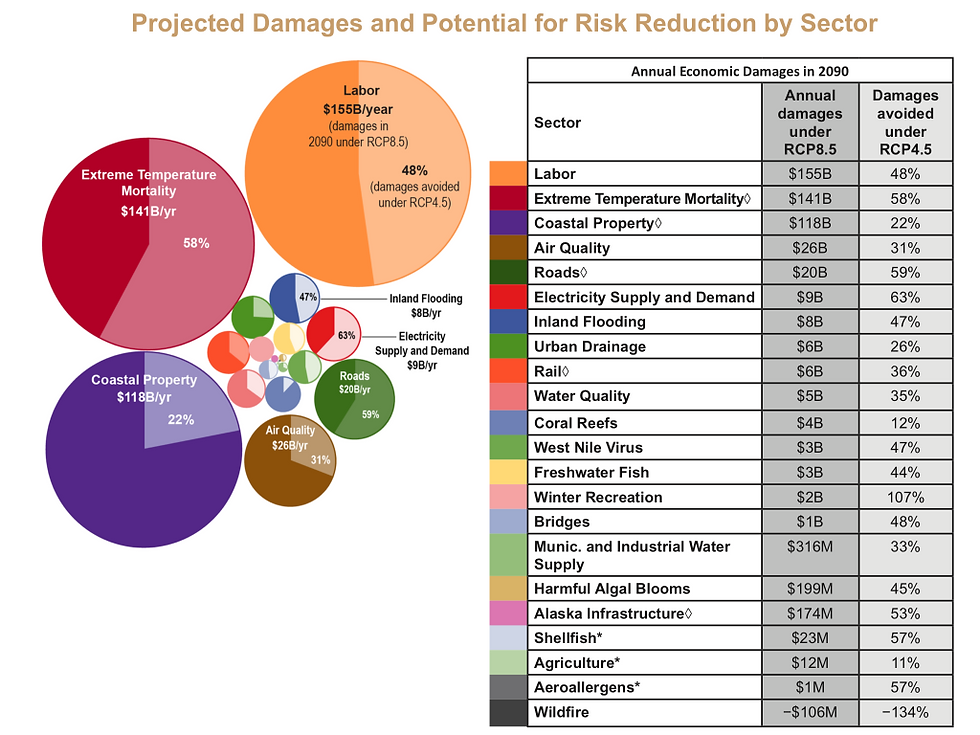The U.S. climate report: An appeal to care and a call to action
- C GE

- Apr 16, 2020
- 4 min read
Updated: Apr 17, 2020
On November 28, 2018, the U.S. Global Change Research Program released the second volume of its Fourth National Climate Assessment (NCA4) – a congressionally mandated quadrennial review produced by 300 scientists and experts from 13 federal agencies, and reviewed by 1,000 stakeholders. Unlike the first volume, which mostly focused on the physical science of climate change, the latest review tells a comprehensive story of the impacts, risks, and adaptation in the continental U.S. It is a long and evocative report with 29 chapters, summaries, and five appendices covering climate-related topics of national interest, regional effects, and responses.

Figure 1. Global warming trends as influenced by natural and human factors.
“Summary of Findings” and “Chapter 1: Overview” frames the discussion by synthesizing the report to easily digestible messages. These are: (1) climate change is not a distant issue any more; (2) it is affecting every single one of us, in every region of the U.S. across multiple sectors; (3) current mitigation and adaptation efforts have expanded but have yet to reach a level necessary to avoid substantial economic and environmental damage over the coming decades; and (4) if we continue in the same path, we will see more serious impacts in the future. Chapter 2 on “Our Changing Climate”, which is based on Volume I, hammers down the message that the global climate is rapidly changing (from warming and acidifying oceans, rising global sea levels and flooding, drastic changes in precipitation and storm events, to melting of Arctic sea ice and ice sheets) and based on model simulations, it is primarily driven by humans. This was shown in Fig. 1 below (Fig. 2.1., NCA4), where global temperatures match observed temperature record closely when considering human influences only.
When going through the region per region impact, the key message that we are way past a wake-up call is growing increasingly clear. From the agricultural effects in Nebraska, Kansas, and Oklahoma, wildfires in California; vanishing coastal communities in Louisiana; nuisance flooding in South Carolina; harmful algal blooms leading to ecological imbalance in the Great Lakes; spread of disease vectors in Georgia and Vermont; and air and water quality risks in major cities – all these and more are pointing to the undeniable fact that climate change is here and its effects are happening right before our eyes.
Looking at the coastal effects in Chapter 8, the report estimates that $1 trillion dollars of public infrastructure and private property along the U.S. coastline are at risk due to sea level rise and storm surges. Due to the accelerating pace and extent of coastal flooding and erosion, the NCA4 suggests that “coastal communities will be among the first in the U.S. to test climate-relevant legal frameworks and policies” and thus set precedents on adaptation and mitigation strategies. In the Midwest, specifically, the warming trend poses serious effects on the Great Lakes biodiversity and ecosystems and the coastal communities that rely on its services. Other coastal communities such as those found in the Southeast region of the country are also particularly vulnerable due to risks from flooding, vector-borne diseases, and natural ecosystems transformations. Just like the loss of some Great Lakes coastal wetlands, prairies, and vegetated floodplains along rivers and streams, the Southeast region will also see significant changes in its coastal landscapes as temperatures continue to rise. One notable change is the northward movement of mangrove forests, replacing salt marshes. Shared effects include migration of organisms including invasive species, deleterious effects on tourism, transportation and shipping, disturbances in water flow patterns, and indirect cultural effects. The report also estimates that under the RCP8.5 and no adaptation, coastal property damages across the U.S. could reach $3.6 trillion through 2100. Fortunately, more than half of said damages are avoidable through adaptive measures such as shoreline protection.

Figure 2. Projected damages and potential risk reduction by sector.
While the NCA4’s message is clear and the call for action urgent, it is inevitable to feel disheartened by the current administration’s stance on the efforts to protect the only planet that we have. In tackling climate change challenges, short-sightedness and weak leadership is expected to further increase economic and workforce cost in the future as show in Fig. 2 (Fig. 29.2, NCA4). In addition, the report highlights that climate change affects the vulnerable members of the society the most. This could mean that climate denialism and special interest protection can further perpetuate existing environmental injustice.
In summary, my final thoughts after reading the NCA4 are: (1) this review gives a dire warning that the devastating impacts of climate change are here and that they are going to get worse unless we act now; (2) Trump administration’s actions of putting special interest ahead of national interest (e.g. withdrawal from 2015 Paris agreement, weakening oversight on environment, safety, and health) puts us a few generations backward and it might be up to our collective individual efforts to mitigate future impacts; and (3) lastly, for our future generations, this report shows that we are aware of what is happening to our planet and that we have ideas on how to stop it from getting worse. How we respond now would be reflected on the kind of world we left for them.
###


Comments